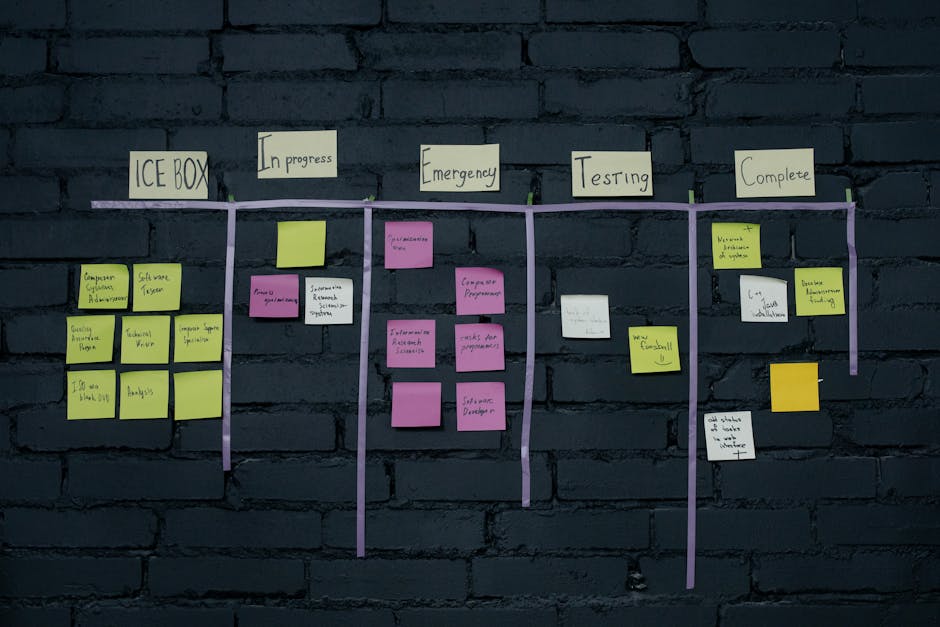Embracing Agility: How Agile Methodologies Transform Modern Workplace Management
“Agile methodologies have revolutionized how organizations approach project management and software development. This article explores the fundamental principles of Agile, its various frameworks, and practical applications across different workplace environments. Learn how embracing Agile can enhance flexibility, foster collaboration, and drive continuous improvement in your organization. ”

Embracing Agility: How Agile Methodologies Transform Modern Workplace Management
In today's rapidly evolving business landscape, organizations are constantly seeking approaches that allow them to adapt quickly to changing requirements and deliver value efficiently. Agile methodologies have emerged as a powerful solution, transforming how teams collaborate and execute projects across industries. For HR managers, IT leaders, facility managers, and educational administrators, understanding the principles and applications of Agile can be a game-changer in creating more responsive and productive workplace environments.

What Are Agile Methodologies?
Agile methodologies represent a set of flexible and iterative approaches to project management and software development that prioritize collaboration, customer feedback, and rapid adaptation. Unlike traditional waterfall methods that follow a linear, sequential process, Agile breaks projects into smaller, manageable phases called sprints, allowing for continuous improvement and adjustment based on stakeholder input.
At its core, Agile is guided by the values outlined in the Agile Manifesto:
- Individuals and interactions over processes and tools
- Working solutions over comprehensive documentation
- Customer collaboration over contract negotiation
- Responding to change over following a plan
These principles have revolutionized not just software development but project management across various industries, creating more adaptive and responsive work environments.
Popular Agile Frameworks
Several frameworks fall under the Agile umbrella, each with unique characteristics suited to different organizational needs and contexts.
Scrum
Scrum is perhaps the most widely recognized Agile framework, particularly in software development. It organizes work into time-boxed iterations called sprints (typically 2-4 weeks) and defines specific roles:
- Scrum Master: Facilitates the process and removes impediments
- Product Owner: Represents stakeholders and prioritizes the product backlog
- Development Team: Self-organizing group that executes the work
Scrum includes ceremonies like daily stand-ups, sprint planning, sprint reviews, and retrospectives to maintain alignment and foster continuous improvement.
Kanban
Kanban focuses on visualizing workflow and limiting work in progress (WIP) to optimize efficiency. Using a Kanban board, teams can:
- Visualize their workflow
- Limit WIP to prevent bottlenecks
- Manage flow to ensure smooth operations
- Make process policies explicit
- Implement feedback loops for improvement
This approach is particularly effective for teams with a continuous flow of incoming requests rather than project-based work.

Lean Software Development
Inspired by lean manufacturing principles, Lean Software Development emphasizes eliminating waste and optimizing the whole value stream. Its core principles include:
- Eliminating waste
- Building quality in
- Creating knowledge
- Deferring commitment
- Delivering fast
- Respecting people
- Optimizing the whole
This methodology is particularly valuable for organizations looking to streamline processes and maximize efficiency.
Extreme Programming (XP)
XP focuses on technical excellence and customer satisfaction through practices like:
- Pair programming
- Test-driven development
- Continuous integration
- Simple design
- Refactoring
- Collective code ownership
XP is ideal for teams facing rapidly changing requirements who need to maintain high-quality code.
Implementing Agile in Different Workplace Environments
The versatility of Agile methodologies makes them applicable across various workplace settings, not just in software development teams.
For HR Managers
Human Resources departments can leverage Agile to:
- Streamline recruitment processes through iterative improvements
- Develop training programs that adapt to employee feedback
- Create more responsive performance management systems
- Implement change management initiatives with greater stakeholder involvement
By applying Agile principles, HR teams can become more responsive to organizational needs and employee concerns.
For IT Managers
IT departments were early adopters of Agile and continue to benefit from:
- More predictable software delivery through sprint planning
- Reduced defects through continuous testing and integration
- Better alignment with business needs through regular stakeholder feedback
- Increased team morale through self-organization and purpose
The iterative nature of Agile allows IT teams to adapt quickly to changing technologies and business requirements.

For Facility and Real Estate Managers
Facility managers can apply Agile concepts to:
- Manage space planning projects through incremental improvements
- Respond more quickly to changing workplace needs
- Prioritize maintenance and improvement tasks based on user feedback
- Visualize workflows using Kanban boards for service requests
This approach helps create more responsive and user-centered workplace environments.
For Educational Institutions
Schools and colleges can implement Agile to:
- Develop curriculum through iterative feedback cycles
- Manage IT infrastructure projects with greater flexibility
- Improve administrative processes through continuous improvement
- Foster collaboration between departments and stakeholders
Educational institutions that embrace Agile can become more adaptive to student needs and technological changes.
Challenges and Considerations
While Agile offers numerous benefits, organizations should be aware of potential challenges:
Cultural Resistance
Transitioning from traditional management approaches to Agile requires a significant cultural shift. Organizations must foster a culture that values:
- Transparency and open communication
- Comfort with ambiguity and change
- Trust in teams to self-organize
- Learning from failures
Without addressing cultural factors, Agile implementations often struggle to deliver their full potential.
Scaling Agile
As organizations grow, scaling Agile beyond individual teams becomes increasingly complex. Frameworks like SAFe (Scaled Agile Framework), LeSS (Large-Scale Scrum), and Nexus offer approaches to coordinate multiple Agile teams working on related products or services.
The key challenge is maintaining agility while ensuring alignment across the organization. This requires thoughtful governance structures and communication channels.
Hybrid Approaches
Not all projects or teams benefit equally from pure Agile approaches. Many organizations find success with hybrid models that combine elements of Agile with traditional project management techniques. This flexibility allows teams to adapt methodologies to their specific contexts and requirements.
Measuring Agile Success
To evaluate the effectiveness of Agile implementations, organizations should consider metrics beyond just output:
- Cycle Time: How quickly work moves from start to completion
- Lead Time: The total time from request to delivery
- Team Velocity: The amount of work completed in a sprint
- Customer Satisfaction: How well deliverables meet stakeholder needs
- Employee Engagement: Team morale and satisfaction with the process
These metrics provide a more holistic view of Agile's impact on both productivity and workplace culture.

Getting Started with Agile
For organizations looking to implement Agile methodologies, consider these practical steps:
- Start Small: Begin with a pilot team or project to learn and adapt before scaling
- Invest in Training: Ensure team members understand Agile principles and practices
- Secure Leadership Support: Executive buy-in is crucial for overcoming organizational barriers
- Focus on Mindset, Not Just Practices: Emphasize the values and principles behind Agile, not just the ceremonies
- Adapt to Your Context: Modify frameworks to suit your specific organizational needs
Remember that streamlining workplace tasks through Agile is a journey of continuous improvement rather than a destination.
Conclusion
Agile methodologies offer a powerful framework for navigating the complexities of modern workplace management. By embracing iterative approaches, fostering collaboration, and prioritizing adaptability, organizations can respond more effectively to changing requirements while delivering greater value to stakeholders.
Whether you're managing software development, HR initiatives, facility operations, or educational programs, the principles of Agile can help create more responsive, efficient, and satisfying work environments. The key lies not in rigid adherence to specific frameworks but in embracing the mindset of continuous improvement and adaptation that defines the Agile approach.
As workplace demands continue to evolve, organizations that can embody agility in their processes and culture will be best positioned to thrive in an increasingly dynamic business landscape.